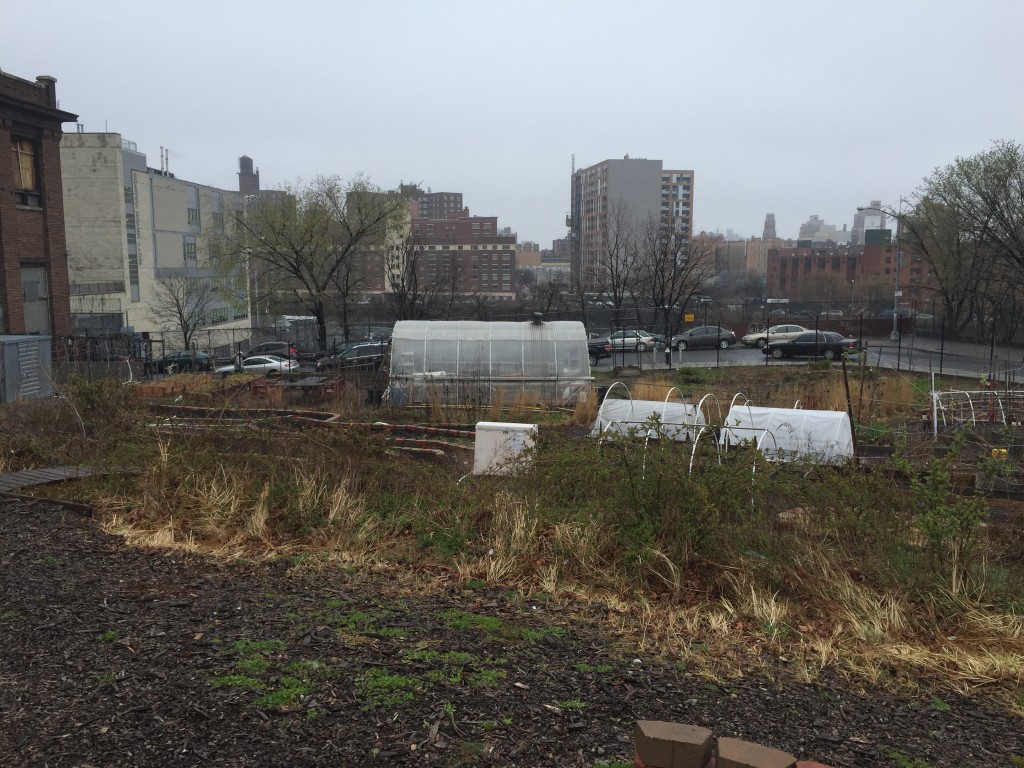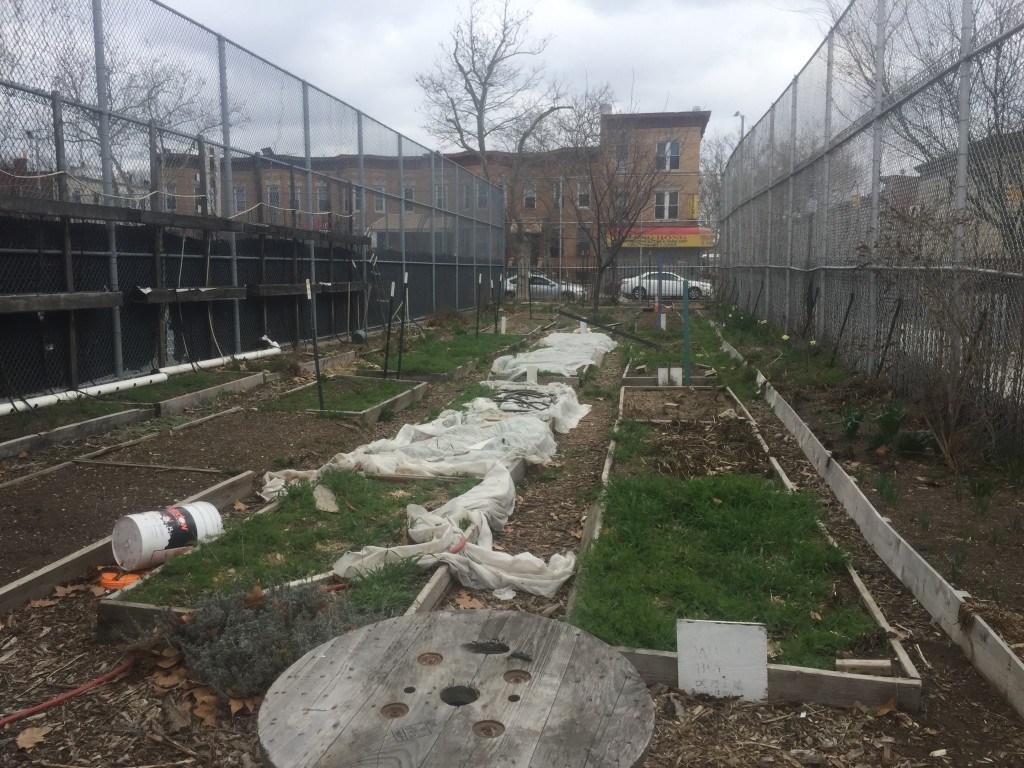Christina Garmendiz, 48, grew up on a farm in Guyana that stretched for more than three miles, she says, where she learned the process of growing foods and raising cows, chickens and goats. She moved to New York when she was 18 years old — and 30 years later, appreciates more than ever the importance of the skills she learned.
“Most people rely upon industries that manufacture [produce], so farming is hidden now” she said, as she watered seeds in the greenhouse at New Roots Community Farm in the Bronx, where she has been growing her own food for three years.
The farm, run by the International Rescue Committee, has about 40 members who pay $25 a year for their plots, and for access to a greenhouse, a beehive box, farming conferences around the city and a composter. Garmendiz, a member of its five-person governing committee, uses most of her crops for her family of three college-aged children and her mother, whom she also cares for.
“It’s beneficial, it’s not just a hobby,” said Garmendiz.

New Roots Community Farm members have access to a greenhouse, beehive and a composter at the Bronx location. Photo: JoVona Taylor.
Research from NYU’s Steinhardt School of Culture, Education and Human Development released early in March found that most urban farmers cite social motivation, not profit, as their reason for starting to farm. The majority of the 370 urban farms surveyed had sales below $10,000 per year and only one third operated as a nonprofit model.
Garmendiz tries to avoid genetically-modified foods (GMOs) and foods treated with pesticides, and her garden plot helps to reduce her dependence on supermarkets that carry these items. She primarily grows vegetables and herbs like tomatoes, garlic and thyme.
Sharon Griffin, 54, a fellow New Roots farmer, says she’s always tried to balance her love of agriculture with raising six children and working multiple positions at the Children’s Aid Society. She grew up in a Trinidadian household where her grandmother grew produce like passionfruit, guava and lemons.
When Griffin moved to New York, she tried to grow lettuce and tomatoes on her banister, but the police would tell her to stop. Now retired and an empty nester, she hopes to dedicate her free time farming full-time. She also makes natural soaps, oils and lotions, which she sells at the Bronx Gateway Center Mall during the warm seasons.
“It’s a lifestyle that you really have to love,” she said. “I feel like even though I’m not bringing in a lot of money doing what I’m doing, I don’t care. I feel like I have total freedom.”
Griffin has been trying to pursue a farm internship, but says that her age seems to be a hindrance, because she sees younger applicants getting positions. She understands the logic, but thinks that farms could benefit from having older team members.
“He may have the physical labor, but I have the smarts to get around the work and do it an easier way,” said Griffin, who stays up-to-date on farming techniques by attending workshops and conferences and reading books. “You may have bad practices for years that you’re passing on to him.”
Age also plays a part in Kristina Erskine’s budding career in urban agriculture. She currently works at Bushwick Campus Farm and Greenhouse in Brooklyn, a non-profit project integrated into the neighborhood educational complex where four separate high schools are housed.
Erskine, who is 20, hopes to create a magazine aimed at people of color focused on natural remedies and recipes. “I feel like there are tons of passionate adults, but I feel like youth do bring different elements, different energy to the work. But, I feel like both sides are valid,” she added.
Erskine has been involved with urban farming since attending Bushwick’s Academy for Environmental Leadership High School on the campus. She is now in her sixth year of farming and is teaching other young farmers at the school, as well as working as a youth advocate for Community Food Advocates and attending Medgar Evers College for environmental science.
Though she still lives with her parents, which offsets much of the financial stress of life in New York City, Erskine feels a need to overachieve in order to make her mark.
“I’m not working to sustain myself in college, but I’m working to sustain myself mentally, spiritually and also in terms of my career path,” she said. “It’s a very unique career path, so it’s very important to me to balance education and experiences.”
She is aware of how difficult urban farming can be. This past winter, bitter storms destroyed the farm’s greenhouse, a major setback for Erskine and her colleagues, who lost all of their seedlings before the spring planting season.

Bushwick Campus Farm in Brooklyn on a cold March day. Farmer Kristina Erskine says the harsh New York winters take a toll on the urban growing area. Photo: JoVona Taylor.
She and David Vigil, a 34-year-old project director at East New York Farms!, agree that customers at farmer’s market in the city should be aware of the time, effort and money that goes in urban agriculture to understand the pricing for their products.
“We all do it because we love it,” said Vigil. “But we have to remind people that even the most experienced farmers with all the best resources still have trouble turning a profit in this country because of what people expect to pay for food.”
East New York Farms! is a non-profit organization dedicated to addressing food justice in the Brooklyn community. The program runs two urban farms and assists more than 50 gardeners around East New York with farmers markets and the Community Supported Agriculture initiative, which allows customers to buy a share in one of the community farms and receive weekly packages of fresh produce at discounted prices.
Vigil notes that there seems to be a lack of awareness and attention in local media and government about who is growing the food New Yorkers eat — the focus on high-tech rooftop farms or hydroponic greenhouses excludes the many small scale urban farmers, including people of color and low income, whom he works with daily.
He says that part of the push for urban agriculture is to educate city dwellers on those sources as well.
Tags: Bronx, Brooklyn, farmers, gardeners, New York City farming, urban agriculture

Your Comments